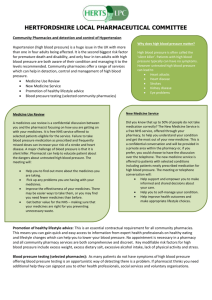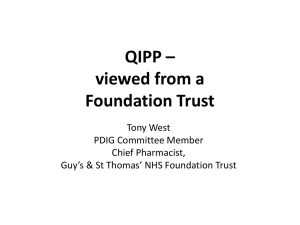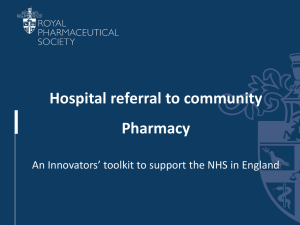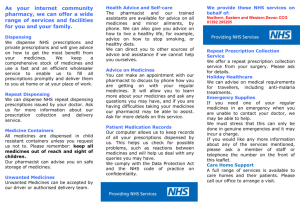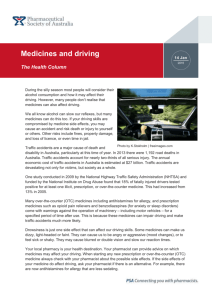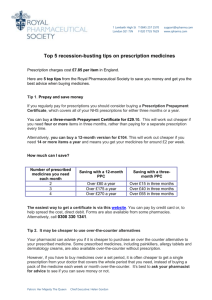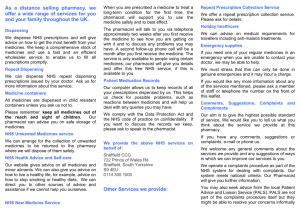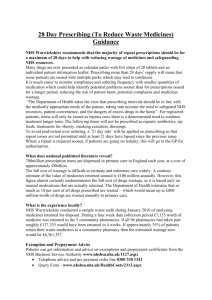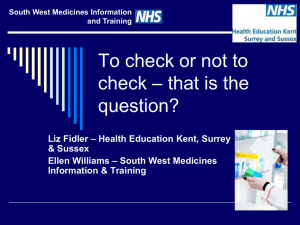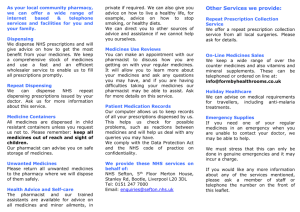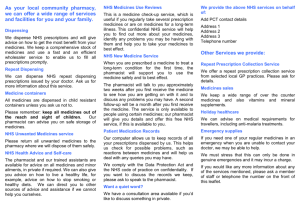Benefits Realisation - ePrescribing Toolkit
advertisement
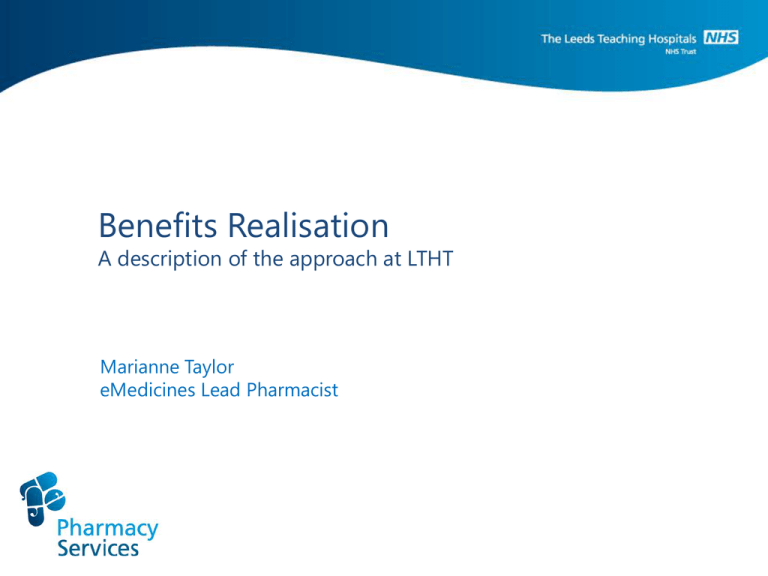
Benefits Realisation A description of the approach at LTHT Marianne Taylor eMedicines Lead Pharmacist Background • Clinical pharmacist with a background in medicines information and medicines risk management • eMedicines Lead Pharmacist since 2008, with experience of an eDischarge system implementation • Part of a multidisciplinary team implementing an ePMA system Why benefits are important… • Benefits should drive the change, from the business case onwards • Monitoring benefits helps to direct the project and inform decision making • Delivering benefits is key to a successful project implementation But, measuring and tracking benefits is often overlooked or under resourced. The Integrated Digital Care Fund (formerly Safer Hospitals, Safer Wards): Benefits Management Process Stage 1: Identify (complete – you are at Stage 2) Stage 2: Define & Plan Stage 3: Track & Realise Stage 4: Evaluate Product: Value for Money (VfM) profile Product: Statement of Planned Benefits Product: Benefits Tracker Product: Post-Project Review Please insert Project Name and Trust here 2014/15 2015/16 2016/17 2017/18 2018/19 2019/20 2020/21 2021/22 1.00 0.97 0.93 0.90 0.87 0.84 0.81 0.79 £ - £ - £ - £ - UNDISCOUNTED TOTAL OF COSTS AND BENEFITS DISCOUNTED TOTAL OF COSTS AND BENEFITS £ £ £ - £ £ £ - £ £ £ - Undiscounted costs Undiscounted benefits £ £ - £ £ - £ £ Discounted costs Discounted benefits £ £ - £ £ - £ £ TOTAL COSTS Discounted benefit to cost ratio 2022/23 2023/24 0.76 TOTAL £ - £ - £ £ £ £ - - £ - £ - £ - £ - £ - £ - £ £ £0 £ - - £ £ £ - £ £ £ - £ £ £ - £ £ £ - £ £ £ - £ £ £ - £ £ £ - £ £ - £ £ - £ £ - £ £ - £ £ - £ £ - £ £ - £ £ - £ £ - £ £ - £ £ - £ £ - £ £ - £ £ - £ £ - £ £ - - £ - £ £ £ - Project Ref. No. Created ddmmyy Reviewed #DIV/0! Short title summarising the expected benefit Benefit Description Fuller description of the benefit and its context Owner Who is responsible for this profile and for ensuring the expected benefit is achieved/realised fully Support Objective(s) List the organisational or departmental objective(s) this benefit contributes to. Q2 14 27/06/2014 Δ £ Q3 14 30/09/2014 Δ £ Ref Benefit Δ A1 Reduced time spent entering assessments 15% £12,500 5% £1,042 15% £3,125 B3 Increase in accuracy of early warning score calculation 10% n/a 6% n/a 11% n/a C2 Reduced instances of hospital acquired infections List the key technology, process, organisational or other changes required to achieve this benefit Enablers Benefit Type Economy (directly reduces cost) In what units and/or what Unit of qualitative Measure terms is the benefit yes/no Efficiency (frees up time for other activities) Estimated or Baseline measured Value current value Effectiveness yes/no (improves the delivery or quality of care outcomes) £ p.a. Q4 14 Δ Q1 15 Δ £ Cumulative (Last 4 Qs) £ p.a. £ Target Value How will Estimated the or target Method measure future be value taken? 0% 1.50% £1,250 £1,250 TOTALS £22,500 £1,042 £4,375 £0 £0 £5,417 NOTE: If the measurement or calculation approach applied differs from that stated in the Benefit Profile, please explain here measured Financial Value and Assumptions If applicable, state the overall financial value and supporting assumptions (i.e. the estimated value of each unit of measure) Start Date The date from which some or all of the expected benefit will be achieved mmyy Measuring Start Date mmyy Completion Date The date by which you expect the full level of benefit to be achieved mmyy What: A Word document providing greater detail of each benefit and when you expect to achieve them. Includes relevant dependencies, assumptions and describes how each benefit will be measured When: During the application process When: Within one month of receiving your award or this document (whichever is the latter). Updated periodically as more information about individual benefits becomes known. Why: It helps you build support amongst internal stakeholder and demonstrates that the project meets the required level of return for central investment (>1 to 1 for ePrescribing and >1.5 to 1 for all other projects) 3% £10,000 £4,167 n/a yes/no What: A spreadsheet providing an early view of your expected benefits, both financial and non-financial. Includes estimated costs and shows the anticipated VfM return (total financial benefit divided by cost) 4 Target ddmmyy Insert your SHSW project reference number Benefit Title 0.73 £ £ Benefit category 5. cost savings 6. increased productivity of staff 7. Other quantifiable benefits TOTAL BENEFITS Benefit No. Benefit Profile Value for Money template Financial Year Discount rate Cost category (excluding VAT) 1. Initial Capital expenditure 2. Ongoing capital costs 3. Transition costs 4. Additional revenue costs associated with investment Why: Understanding key dependencies, governance arrangements, and how/when benefits will be measured improves your chances of achieving them. It also gives your local contact in the IDC Fund/SHSW team the information they need to support you properly What: A spreadsheet used to record progress against each benefit. It shows when they start to accrue and the actual value delivered What: A Word document that compares the benefits defined in the ‘Statement of Planned Benefits’ with what was achieved on the ground When: Updated once every three months after completing your Statement of Planned Benefits When: Once the initial project has been completed and associated changes have had time to bed-in. It may be updated several times for major change programmes. Why: Tracking benefits is an essential part of measuring progress towards your main objectives. As a whole, the Integrated Digital Care Fund/SHSW needs to show that the benefits delivered justify the original investment. It will also provide a basis for future funding rounds Why: Recording the outcomes and benefits you deliver is a good way of communicating success within your organisation. Where actual benefits vary from those expected (more, less or different) the difference can also be recorded here. This should provide a valuable resource for future projects in the Trust and the wider NHS community Stage 1: Identify the benefits • Benefits were listed in the business case under the following categories: • Patient safety • Clinical effectiveness • Quality and clinical governance • Operational productivity • Identified with the help of previous project experience and discussion with other NHS trusts • Alongside this we developed a benefits list Stage 2: Define and Plan • From initial list we have chosen 11 key benefits • Majority can be baselined with data that is already being collected • We have chosen not to measure impact on length of stay • We expect new benefits and to become apparent as the project progresses; these will be logged • We also expect to find disbenefits and they will also be logged Benefits – examples: • Medicines allergies • Eliminate the prescribing of medicines that patients are allergic to • Reduce allergic reactions caused by medication • Measured by incident data, system data and IMPACT • Missed doses • Reduce missed doses • Measured by incident data, system data and prescription chart audit • Time savings • Reduced time looking for charts, ordering medicines, administering medicines • Measured by user survey Start early and keep it simple • Identifying benefits for the business case is just the start • What are key issues for organisation? • What do you already measure? • Prioritise Any questions? Benefits guidance for ePrescribing available from NHSE at http://www.technologystrategy.england.nhs.uk/pg/cv_content/content/view/ 121292/65825?cview=67602&cindex=0
